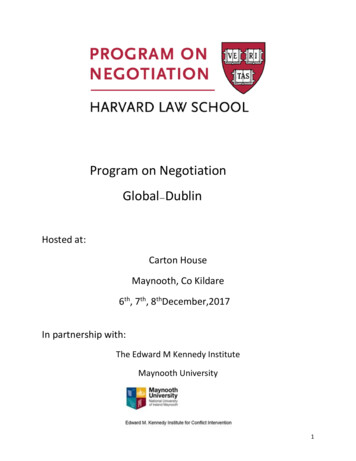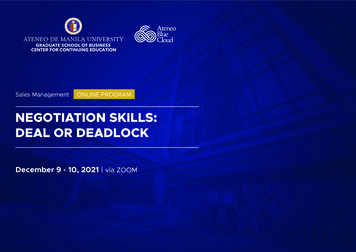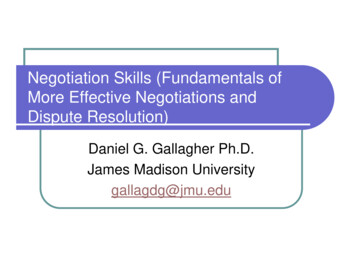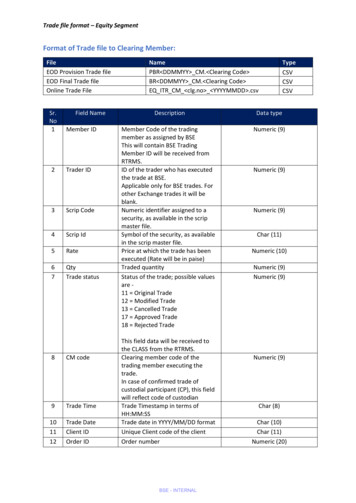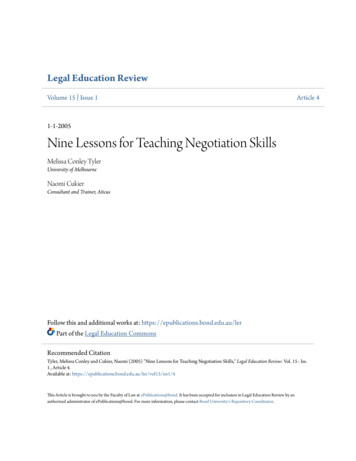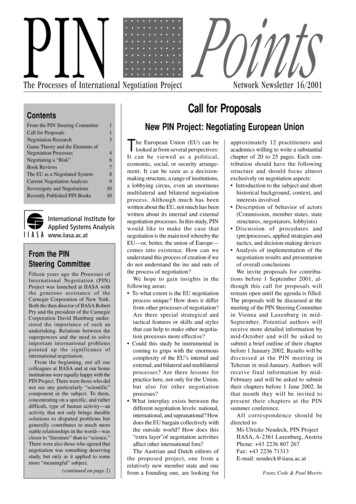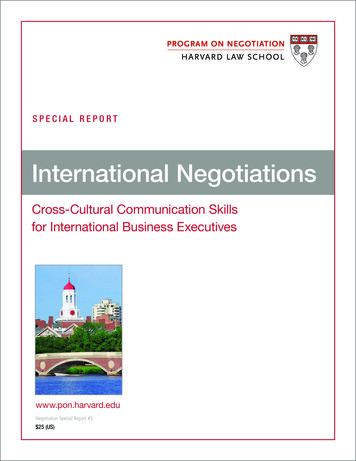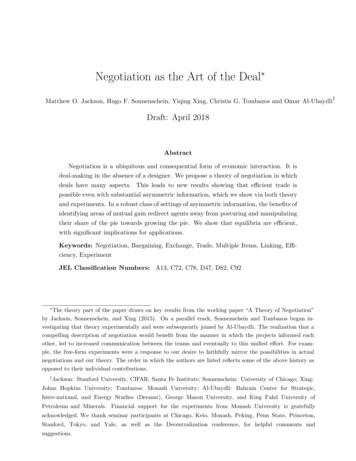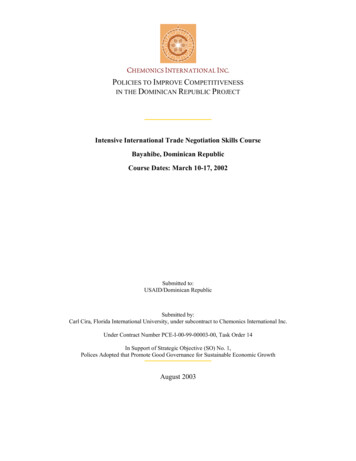
Transcription
POLICIES TO IMPROVE COMPETITIVENESSIN THE DOMINICAN REPUBLIC PROJECTIntensive International Trade Negotiation Skills CourseBayahibe, Dominican RepublicCourse Dates: March 10-17, 2002Submitted to:USAID/Dominican RepublicSubmitted by:Carl Cira, Florida International University, under subcontract to Chemonics International Inc.Under Contract Number PCE-I-00-99-00003-00, Task Order 14In Support of Strategic Objective (SO) No. 1,Polices Adopted that Promote Good Governance for Sustainable Economic GrowthAugust 2003
TABLE OF CONTENTSExecutive SummarySECTION IGeneral Background & Introduction to Instructors and ParticipantsA. General BackgroundB. The Florida International University Team of InstructorsC. The Participant GroupD. Dynamics of the Group11234SECTION IIFinal Preparation & Delivery of CourseA. Saturday, March 9: Final Preparations and Logistics CheckB. Sunday, March 10: Opening and IntroductionC. Monday, March 11: Protagonists and Negotiating ProcessesD. Tuesday, March 12: Explanation and Analysis of Elements of theMultilateral Trade Negotiation ProcessE. Wednesday, March 13: Explanation of the SNS Problem CaseF. Thursday, March 14: First Day of NegotiationsG. Friday, March 15: Second Day of NegotiationsH. Saturday, March 16: Third and Final Day of NegotiationsI. Sunday, March 17: Instructors Evaluation of Negotiations6667101011111212Course Schedule14ANNEX A
Executive SummaryFlorida International University (FIU) was contracted to provide a compressed and customizedversion of its International Trade Negotiation Skills Course under the United States Agency forInternational Development’s (USAID) Policies to Improve Competitiveness in the DominicanRepublic project. The project is being implemented under a task order with ChemonicsInternational Inc. The course was tailored by FIU to the specific needs expressed by theDominican Foreign Relations Ministry and Chemonics/Strategy Center. It was successfullypresented to 34 Dominicans during the March 10-17, 2002 period. The course was inaugurated inRomana-Bayahibe on Sunday evening, March 10, with opening remarks by Ms. Janice Jacobs,Deputy Chief of Mission, United States Embassy in Santo Domingo and the DominicanUndersecretary of Foreign Relations Mr. Santiago Tejada.The course provided 60 hours of instruction and negotiation practice over an eight-day period. Itconsisted of 24 class hours of preliminary briefings and instruction and 36 hours of simulatednegotiations. The negotiation problem case was based on the actual 1993-1995 negotiationsamong Brazil, Argentina, Paraguay and Uruguay, on the harmonization of MERCOSUR nations’pharmaceutical registries. The course developed quite well and was well received. Theparticipants responded seriously and professionally to course methodology and contentthroughout the week.In his final remarks at the closing of the course on Sunday morning March 17th, UndersecretaryTejada, who had observed several hours of simulated negotiating sessions and was presentduring the prior two daily FIU instructor evaluations, expressed his gratitude and satisfactionwith the course. Among his appreciative words, he stated that the course had enabled him toidentify five “new negotiators” whom he intended to assign to greater trade negotiatingresponsibilities immediately. He expressed high praise for the course to the FIU instructors andhis appreciation to USAID, Chemonics, and FIU. The course schedule is included in Annex A.
SECTION IGeneral Background & Introduction to Instructors andParticipantsA. General BackgroundThe Dominican Republic (DR) in recent years has joined the general economic liberalizationtrend in Latin America and the Caribbean. A great deal of the initiative and the impetus foreconomic integration came during the prior Dominican administration. The Dominican Republicmade significant progress in the negotiation and signature of free trade agreements with CentralAmerica and with the Caribbean Community (CARICOM). As is still the case in many countries,Dominican public sector positions are largely unprotected by civil service status. Thus, after thecurrent government took office in August 2000, it dismissed virtually all of the public sectorpersonnel previously involved in the several important negotiation processes to which the DRwas a party.The great majority of the personnel now representing or backstopping the Government of theDominican Republic (GODR) in international trade negotiations have held their present positionsfor under eighteen months. Many still lack the background and the training to confidently andadequately define negotiating positions and strategies, or to take the lead for their country in anactual negotiation setting. On a positive note, the current Dominican administration hasrecognized the pressing need for training and technical help to improve its ability to negotiateeffectively in the contexts of the Free Trade Area of the Americas (FTAA), CARICOM, theCentral America-DR Free Trade Agreement (FTA), the African, Caribbean, and Pacific group ofstates and the World Trade Organization (WTO).In an important recent policy shift, the U.S. Government has begun to project a public posture ofactive interest in and support for the need for trade capacity building among the smallereconomies and the developing countries in general. GODR officials initially made contact withofficials of the Office of the U.S. Trade Representative (USTR) on the issue. The USTR referredthem to USAID, and GODR Undersecretary of State for Foreign Affairs Mr. Santiago Tejada,charged with coordination of all Dominican international trade negotiations, approached USAIDfor assistance.USAID, through its Policies to Improve Competitiveness in the Dominican Republic project,managed by Chemonics International, arranged to contract the Summit of the Americas Center(SOAC) at Florida International University to present an intensive one week version of its twoweek International Trade Negotiation Skills Course for Dominican trade negotiators. Chemonicsmade the initial contacts with FIU in mid-January 2002. In an initial meeting with SOACDirector Carl A. Cira at FIU in Miami on January 23, 2002, Undersecretary Tejada, Chemonics’Strategy Center Director Mr. Antonio Rodríguez-Mansfield, and Chemonics/Washington D.C.Project Manager Mr. Christian Kolar presented the elements of the DR situation and theirtraining needs. SOAC Director Mr. Cira subsequently presented a proposal, and a contract wassigned by February 15, 2002.
CHEMONICS INTERNATIONAL INC.The course was conducted in a cooperative atmosphere that combined seriousness of purposewith a good level of friendly interchange among FIU instructors and Dominican participants.FIU staff greatly appreciated the calm and constant support of Chemonics project AssistantDayana Lora. Unless otherwise indicated, all FIU instructor sessions throughout wereaccompanied by PowerPoint presentations, and all of these were made available to theparticipantsB. The Florida International University Team of InstructorsThrough its subcontract with Chemonics, FIU arranged, directly or via a subcontract, for theparticipation of the following instructors: Dr. Ricardo Zapata, Director of the Trade Unit at the ECLAC (United NationsEconomic Commission for Latin America and the Caribbean) Regional Office forMexico, Central America and the Caribbean, Mexico City; Member, Small EconomiesCommittee, FTAA negotiations; Dr. David Lewis, Vice President of Manchester Trade, Ltd., Washington, D.C. FormerDeputy Director of Commerce, Puerto Rico, advisor on trade policy to CARICOM,Dominican Republic, Jamaica, etc.; Dr. Rodolfo Rua Boiero, President, Center for Studies on Economic Integration andInternational Trade (INTEGRAL), Buenos Aires and Miami, economist and tradepolicy advisor to Argentine, Brazilian, Uruguayan and Paraguayan public and privatesectors, veteran negotiator of various bilateral and Mercosur trade and tariffagreements; representative of Argentine Chamber of Commerce to Business Networkfor Hemispheric Integration (BNHI); Licenciada Liliana Otero, INTEGRAL, pharmaceutical regulatory expert andMercosur negotiator; negotiation training specialist; Ing. Carlos Restaino, INTEGRAL, former executive with Gillette, Inc., managementconsultant and trade negotiation advisor, negotiator of various Mercosur tradeagreements; Dr. Eduardo A. Gamarra, Director, Latin American and Caribbean Center (LACC),FIU, political scientist, expert on U.S.-Latin American political, social and economicrelations and trade policy analyst, author and editor of numerous books and articles onLatin American affairs. Carl A. Cira, J.D., Director, SOAC, attorney, former Deputy Chief, ForeignCommerce Section, Antitrust Division, U.S. Department of Justice; Former MissionDirector, USAID/Colombia, 1997-1999. International trade commentator and analyst.NOTE: Dr. David Lewis has been a regular member of the SOAC instructor group for allprevious courses. However, in this case, the costs of Dr. Lewis’s participation were to be coveredunder an existing consulting contract with the GODR’s Technical Secretariat of the Presidency2 - INTENSIVE INTERNATIONAL TRADE NEGOTIATION SKILLS COURSE
CHEMONICS INTERNATIONAL INC.held by Manchester Trade, Ltd. This arrangement was by instruction of Dr. Santiago Tejada. Asit turned out, Dr. Lewis notified FIU late the night before the opening of the Intensive Coursethat he was unable to participate, as he had been requested by the Dominican Ambassador toremain in Washington to work on urgent matters under the DR-Manchester consulting contract.C. The Participant GroupThe group of 36 persons consisted ofParticipant Profileboth public and private sectorindividuals involved in or connectedPublic Sector Officials: 28with the negotiation of internationalPrivate Sector Officials: 5Public Sector Observers: 3trade agreements for the DominicanTotal: 36Republic. The names and affiliations ofthe participants are included in AnnexPublic sector officials represented the Ministry of ForeignB. As indicated in the text box, thereRelations, Ministry of Industry & Commerce, Ministry ofwere 28 public and five private sectorFinance, Ministry of Agriculture, Central Bank, CustomsAgency, among others. Six were Chief Negotiators and therepresentatives, as well as three publicothers were alternates or technical or substantive supportsector observers. Out of the 28 publicpersonnel.sector personnel, six were ChiefNegotiators/Coordinators and the otherswere alternates or technical or substantive support personnel. Of the private sector group, allwere knowledgeable and well informed on the DR’s negotiating processes. All had beeninvolved consistently in monitoring the DR negotiation process via the Comité Nacional deNegociación Comercial (CNNC), the GODR’s liaison body with the private sector and otherelements of civil society.Based on prior FIU/LACC and SOAC contacts and our close monitoring of the Dominicanpolitical and economic situation, we were aware that the country’s trade negotiation capacity hadsuffered a distinct setback in the last changeover of national governments. From ourconversations with various members of the Dominican group as well as from observation anddiscussion, it was evident that the GODR is still in the process of rebuilding its previous levels offunction and expertise.Nevertheless, the group as a whole was well-prepared and ready to work. The purpose andmethodology of this course are eminently practical, rather than theoretical or academic. Aftersome initial doubts from some, the group attitude toward the course quickly became verypositive, and they became serious and enthusiastic participants in both the preparatory phase andin the simulated negotiations.The rigorous 10-hour daily schedule insisted upon by Undersecretary Tejada was generally keptto by all in the first three days of orientation. Thereafter, the 10-hour schedule was exceededevery day in the phase of the simulated negotiation, as the teams routinely worked overtimetogether to define, refine and discuss their negotiating positions and to prepare documentationand positions for the next day’s negotiation. Virtually all individuals in all groups assumed theirassigned roles fully, staying “in character” with their assigned identities during non-negotiatinghours as well. During the last three days of the course, the participants averaged 10 to 12 hoursGENERAL BACKGROUND & INTRODUCTION TO INSTRUCTORS AND PARTICIPANTS - 3
CHEMONICS INTERNATIONAL INC.of work and the instructors generally accompanied the group and spent an additional hour inanalysis and preparation for the next day’s sessions.D. Dynamics of the Group – Preparation for the Simulated Negotiation Sessions (SNS)The preparation for the SNS requires the FIU instructors to gather personal information on eachparticipant to analyze their prior education, experience, and apparent expertise. This backgroundinformation, together with the instructor team’s observation of their individual comportmentduring the preparatory briefings, allows us to form the four national delegations for the SNS andassign an individual public or private sector role to each person.In order to assemble the teams for the simulated negotiation exercise, the FIU course staff(SOAC, INTEGRAL, ECLAC) also had to consider the differences between this group (allnationals of the same country) and the prior groups of trainees (from several countries) thatattended the two week Miami courses. In the Miami courses, there is normally an entire week tocomplete the task of conforming the SNS teams. In this case, we recognized that we would needto gain a far more rapid understanding of who the DR participants were, both personally andprofessionally, to enable the instructors to do the analytic work needed prior to the formation ofthe four negotiating teams by the third day of the course.During the 2001 Miami courses, the participants came from 15 countries and most participantsdid not know one another before the course. They were out of their home country in a neutralsetting. However, in the case of the DR course, the participants were still in their nationalelement, though away from their homes. Many, if not most, were friends or acquaintances andhad worked together. Attendance at the DR course was essentially mandatory for the publicsector attendees. A number of recognized veteran negotiators and authority figures were amongthe group, and they received due deference from the other participants. Normally, it could also beexpected that some individuals would have outstanding institutional or personal issues with oneanother arising from past interaction. Also, possible inter-institutional sensitivities were potentialsources of friction or undue reticence in their ability or willingness to interact freely indiscussions and role-playing.As noted, several active DR chief negotiators were among the participants. The mix of active andexperienced lead negotiators with less experienced officials, of supervisors with lower levelpersonnel, and of some politically connected, but technically under-prepared persons, withothers, perhaps better educated or more experienced, made the situation potentially sensitivefrom several different standpoints. Clearly, the avoidance of abrasive or overly aggressiveconduct in the course of the negotiations would be greater in the context of expectations forcontinued personal and professional relations after the course. As well, some individualsnaturally would want to use the course as a unique opportunity to impress superiors andcolleagues.Given the foregoing, to get an early handle on the nature of the group, on the first day, the FIUteam asked all to fill out a short background sheet. We asked permission to take a digital photoof each person to be able to match him or her with the correct background sheet in ourdeliberations.4 - INTENSIVE INTERNATIONAL TRADE NEGOTIATION SKILLS COURSE
CHEMONICS INTERNATIONAL INC.During the first two course days of preliminary factual briefings and updates, analysis of thevarious phases of a negotiation and one preliminary two-hour practice negotiation (based on theApril 2001 Hemispheric Trade Ministerial Meeting in Buenos Aires), the instructors observedand studied the participants’ behaviors. During the question and comment periods and thepreliminary negotiation exercise the FIU team sought to identify apparent personalitycharacteristics, evident degrees of prior negotiating experience, self-confidence, professionalknowledge, evident leadership traits, tendencies toward dominance or excessive timidity, and thelike.Based on a combination of objective and subjective criteria, by noon on the third day, the FIUteam would prepare an assignment of a specific role for each participant in the SNS and provideeach of them with a written description of their particular position in the public or private sectorof one of the four Mercosur countries. Thus, to advance the process from the outset, during thefirst day of briefing sessions, three FIU course instructors dedicated themselves primarily to thetask of observation and study of the participants, getting acquainted and beginning to formulatepreliminary matches of individuals and role assignments. These tentative decisions werediscussed and adjusted within the instructor group in the evenings of the first and second fullcourse days and assignments were settled by the morning of the third day.GENERAL BACKGROUND & INTRODUCTION TO INSTRUCTORS AND PARTICIPANTS - 5
SECTION IICourse Implementation – Highlights of the Eight Days atBayahibeA. Saturday, March 9: Final Preparations and Logistics CheckStrategy Center staff assistant Dayana Lora and FIU instructor group members Rodolfo RuaBoiero, Liliana Otero and Carlos Restaino arrived at the Hotel Coral Canoa. The meeting roomset-up was reviewed and adjusted with hotel staff, the projection equipment was set-up andtested, and miscellaneous details were dealt with to assure the smooth start-up of the course thenext day.B. Sunday, March 10: Opening and IntroductionThe remaining FIU team (Carl Cira, Eduardo Gamarra, Cristina Lopez-Gottardi, Ricardo Zapata)and Chemonics Strategy Center staff (Antonio Rodriguez-Mansfield) arrived. U.S. EmbassyDeputy Chief of Mission Janice Jacobs, USAID/DR Democracy and Economic Growth OfficerMr. Donnie Harrington, and USAID Economic Policy Coordinator Mr. Luis Gonzalez arrived.Undersecretary of Foreign Affairs Santiago Tejada arrived. Thirty-six participants and observersarrived and checked in.The formal opening of the course began at 6:00 p.m. and ran until 8:30 p.m.After opening remarks by Mr. Antonio Rodriguez-Mansfield and Dr. Tejada, Deputy Chief ofMission Ms. Janice Jacobs gave a welcoming speech that emphasized the commitment of theU.S. Government to supporting the trade capacity building process in the Dominican Republicand the Hemisphere, and expressed Embassy satisfaction at being able to support thepresentation of the present Intensive International Trade Negotiation Skills Course to Dominicanofficial negotiators.Mr. Carl Cira then spoke briefly on the FIU/LACC/SOAC commitment to hemisphericintegration and our expanding efforts since 2000 to contribute directly to the development ofgreater trade management and negotiating capacity through our International Trade NegotiationSkills Courses offered both in Miami and at large in interested countries of the region. Heexpressed particular satisfaction at FIU’s opportunity to contribute to the advancement of asignificant portion of the official Dominican negotiating group.Dr. Rodolfo Rua Boiero then gave a half hour presentation and description of the content andphilosophy of the course. He explained the methodology to be used in imparting the neededbackground and fundamentals, as well as that for conducting and managing the simulatednegotiation exercises.Dr. Eduardo Gamarra then presented a contextual scene-setting review of the relevant political,economic and social situations in the Western Hemisphere, with special focus on the DominicanRepublic. He highlighted the opportunities and the difficulties of the political situation in theU.S. vis-à-vis progress in the FTAA and other trade negotiating contexts.
CHEMONICS INTERNATIONAL INC.Finally, Undersecretary Santiago Tejada took the podium again to introduce each participant inthe course and to re-emphasize the importance of keeping to the schedule and participatingactively.C. Monday, March 11: Protagonists and Negotiating Processes – Multilateral CommercialNegotiations – Current Actors and PositionsThe first full day’s content was designed to inform and update the group in some detail oncurrent political and economic factors impacting the FTAA and other regional negotiations, andthe trade relations of the Dominican Republic. Equally important, the presenters strove toprovoke reaction, comment and discussion in order to facilitate our parallel task of learningenough about each participant to be able to conform the four negotiating groups by the end of thesecond full instruction day.Session 1. Mr. Carl Cira began with a presentation of the international trade policies of the U.S.and their domestic and international aspects, limits, and problems. Using an historic review ofthe principal elements of U.S. policy toward Latin America and the Caribbean and starting withthe Caribbean Basin Initiative of 1991, Mr. Cira touched upon and explained the main unilateral,multilateral and bilateral instruments of U.S. trade policy in the region.Among the subjects he focused on were: Current legislative obstacles to the conferral of Trade Promotion Authority (TPA) or“Fast Track” on President BushPositions and attitudes of Brazil and Mexico toward FTAALabor and Environmental issues and U.S. positionsSmall Economies – U.S. position on special and differential treatmentNew U.S. interest in bilateral free trade agreements (FTA’s)Caribbean Basin Trade Partnership Act (CBTPA) of 2001Effects of impending U.S. Congressional electionsThe Question & Answer (Q&A) session was lively, reflecting among others, DR interest injoining the U.S.-Central America FTA discussions; interest in a possible U.S. - DR FTA or a DRinclusion in NAFTA; suspicions of ulterior U.S. motives, etc.[Parallel SNS teams definition process: initial indications of interests, attitudes and personalitiesbegan to manifest themselves in this first Q&A.]Session 2. ECLAC/Mexico Trade Unit Chief Ricardo Zapata took charge of the next session insubstitution for Mr. David Lewis. In order to address the subject of “interests and capacities ofnegotiation power” in the multilateral negotiation context, he provided a view from ECLAC ofthe relative strengths of the FTAA negotiation countries based on size of their economies, exportand import capacities, positions within sub regional trading blocs, and resulting comparativeweight at the negotiation table. From the perspective of a member organization of the TripartiteCommittee that manages the FTAA process, and as a participant in the FTAA ConsultativeCOURSE IMPLEMENTATION – HIGHLIGHTS OF THE EIGHT DAYS AT BAYAHIBE - 7
CHEMONICS INTERNATIONAL INC.Committee on the Small Economies, Zapata presented and examined a range of options for thesmall economies.Q&A was predictably focused on DR options and relative strengths and weaknesses, thewish/need to protect the present levels of U.S. concessional preferences and the free zones inwhatever negotiation context ensues.[Parallel SNS teams definition process: significant discussion of the statistical charts used by Dr.Zapata; several individuals had definite favorable or cautious views toward Brazil, high interestin Central America; general unfamiliarity with Mercosur. Some experienced negotiators showedconsiderable depth in formulating questions and comments.]Session 3. Dr. Ricardo Zapata continued in the next section, dealing with the issues confrontingthe Dominican Republic and other smaller economies in the FTAA negotiations.(NOTE: Originally this subject was also to have been covered by Dr. David Lewis, and here weadd an important clarification. Even apart from the last minute, fuerza mayor absence of Dr.Lewis, it was never the intent of FIU to give an ex ante, specific analysis and critique of theDR’s negotiation positions before this kind of group. In our view, such a critique, coming fromnon-Dominicans, presented before 36 well-connected Dominican public and private sectorofficials, at the outset of an event sponsored by the United States Embassy, would have beeninappropriate and imprudent. We respectfully suggest that if the GODR or the Foreign Ministrydesires that sort of dispassionate analysis and strategic and tactical recommendations, it shouldseek these via a separate consulting mechanism, with the required degree of frankness andconfidentiality.)In light of the foregoing, we agreed that the better course for thorough but “non –hazardous”treatment of the subject was to draw out the central issues and doubts on the DR’s positions fromthe participants themselves, and allow them to debate the questions and priorities so revealed.Thus, at the end of his second presentation, Dr. Zapata informed the participants that we weresetting out three short exercises designed to produce the information. The participants wereasked to divide into three groups, discuss the issues over lunch, and return to present theirconclusions and suggestions in the first afternoon session.Session 4. As planned, in this first session of the afternoon, Dr. Ricardo Zapata focused theparticipants on the subject of the goals and strategic options of the Dominican Republic, usingthe methodology explained above. The three groups had met and produced three extensive listsof concerns and suggested problems and priorities. The spokesperson for each of the three in turnset out the responses that his/her group had generated. Dr. Zapata wrote these on the whiteboard,eliminating duplications as the session progressed. The debate and discussion generated fullyengaged the group, and took up the bulk of the session. Concerns emerged over a lack of cleargoals and a sensation of not being fully aware of the potential effects of trade agreements. Therewas a feeling that the private sector and most sectors of the GODR itself were not fully apprisedof the nature of the ongoing trade discussions.8 - INTENSIVE INTERNATIONAL TRADE NEGOTIATION SKILLS COURSE
CHEMONICS INTERNATIONAL INC.Session 5. Mr. Carl Cira next focused the group on the subject of the new trend in U.S. tradepolicy of negotiation of bilateral free trade agreements. The idea was to give a clear and perhapsa sobering idea of the full implications for a potential bilateral FTA partner, like the DR, impliedby entering a bilateral negotiation with the U.S. Using the example of the current Chile – U.S.FTA negotiations, he covered the ten year history of the Chile - U.S. process, the high nationalpriority given by Chile, the consequent major investment of time, resources and funds by privateand public sector officials and ex-officials, the bipartisan, sophisticated and determined nature ofChile’s political commitment and lobbying effort. The cautionary lesson was that despite all ofChile’s enormous investment of political capital and treasure during 2001, the final U.S.-Chiledocument was still under negotiation and the most contentious elements now clearly derive morefrom U.S. domestic political imperatives than from any Chilean issues. Administrationdifficulties in negotiating a Senate vote on TPA have stalled progress with Chile.Mr. Cira also discussed the significance of the U.S.-Central America discussions and the chancesthat the U.S. would incorporate the DR into that process. The CBTPA preferences were alsotouched upon and Mr. Cira noted the uncertain potential effects on DR free zone textileproduction of the last minute promises made by the Administration to U.S. producers to securethe last vote in the House for TPA in December 2001.Q&A was lively and many of the questions and comments showed a general concern overperhaps being left out of U.S. plans. Discussion of other options and opportunities withCARICOM, the EU-ACP group, etc. as alternatives were discussed.[Parallel SNS Teams definition process: further solid performances by standout individuals.Increasing participation and revelation of character and personality as well as degrees ofexperience and knowledge.]Session 6. Dr. Zapata next took up the formation of alliances and coalitions of countries in theFTAA context. Much of the subsequent Q&A again turned on what needed to be done to gainaccess to the U.S.-Central America discussions, which countries may be willing to press for theDR’s case, and what the options and dangers were.[ Parallel SNS Teams definition process: more indications of personal traits, experiences andabilities allowing growing FIU instructor consensus on SNS teams and assignments.]Session 7. Dr. Rodolfo Rua Boiero next began the course phase of specific preparation for theSNS, taking up the nature of national negotiating strategies in the context of multilateral,regional and international commercial negotiations, and the steps in their design and activation.After a Q&A period the first full instruction day ended.Distribution of the Negotiating Problem Case. All participants were given copies of a 30-pagedocument explaining the 1993 Mercosur Pharmaceutical Registry Negotiation that is the basisfor the SNS. They were asked to read and study it thoroughly by Wednesday morning when itwould be discussed in detail to prepare them to deal with it during the simulated negotiationbeginning on Thursday.COURSE IMPLEMENTATION – HIGHLIGHTS OF THE EIGHT DAYS AT BAYAHIBE - 9
CHEMONICS INTERNATIONAL INC.D. Tuesday, March 12: Explanation and Analysis of Elements of the Multilateral TradeNegotiation ProcessThe second full day of instruction wa
Intensive International Trade Negotiation Skills Course Bayahibe, Dominican Republic Course Dates: March 10-17, 2002 Submitted to: USAID/Dominican Republic Submitted by: Carl Cira, Florida International University, under subcontract to Chemonics International Inc. Under Contract Number PCE-I-00-99-00003-00, Task Order 14
